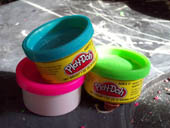
Purpose
To determine whether Play-Doh loses volume after it’s played with or if it the amount of Play-Doh never changes.
Additional information
Play-Doh is kept in cyndrilical canisters. You can measure the volume of the Play-Doh by using the formula for the volume of a cylinder. It is helpful to measure everything in the same unit of measurement, such as centimeters. The volume of a cylinder is found by multiplying the area of its circular base by the height of the cylinder. The area of a circle is found by measuring the radius of the circle, squaring it and multiplying it by Pi (3.14). The end result is in cubic centimeters.
Sponsored Links
Required materials
- 3 cans different colored Play-Doh
- Calculator
- Ruler
- Journal or logbook
Estimated Experiment Time
A few hours.
Step-By-Step Procedure
- 1. Measure the volume of each color Play-Doh right out of the canisters – they will be in a cyndrilical shape. Record the volume in your logbook
- 2. Play with each color of Play-Doh for about ten minutes. Mush it, smash it, separate it and shape it into different shapes.
- 3. Form each color of Play-Doh back into a cyndrilical shape. You can use the canisters to help you if you need to.
- 4. Measure the volume of each color of Play-Doh again and record in your journal or logbook.
Note
You may need an adult’s help going to the store and purchasing 3 canisters of new Play-Doh. It is helpful to lay down newspaper or a mat on the floor or counter before playing with and measuring your Play-Doh. You will also need to be familiar with mathematical terms such as diameter, radius, Pi, squared, cubed, etc.
Observation
Did the volume of the Play-Doh reduce after playing with it? Was the volume the same as when it originally came out of the canister? If the volumes were different, what do you think was responsible for the change in measurements?
Result
The volume of the Play-Doh will most likely remain the same after playing with it because nothing was added and nothing was taken away. If your experiment shows the volume of the Play-Doh being significantly less after having been played with than before, explore other possible reasons for the change in volume. Were your calculations off? Were there any uncontrollable external factors that could have affected the volume of the Play-Doh?
Sponsored Links
Take a moment to visit our table of Periodic Elements page where you can get an in-depth view of all the elements,
complete with the industry first side-by-side element comparisons!